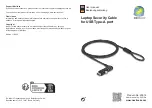
Using passwords
Using passwords
To make sure only authorized persons may work on your computer,
you can set different kinds of passwords. Then prospective users
will have to know the proper passwords in order to access your
computer or data.
You can set the following passwords in your computer:
Power-on password
Screen saver password
Hard-disk passwords
Windows password
Supervisor password
Network password
Power-on password
You can set a power-on password to help prevent unauthorized
users from starting up your ThinkPad computer.
If you set a power-on password, the password prompt appears on
the screen whenever you turn on the computer. You must enter the
correct password to start using the computer.
Note:
If you forget your power-on password, you cannot reset it.
You must take the computer to an IBM reseller or IBM
marketing representative to have the password canceled.
To set a power-on password, refer to the online user's guide.
Screen saver password
You can set a screen saver password. Once the screen saver has
started, only those who know the password can close the screen
saver and resume operating the computer.
Note:
The screen saver password does not thoroughly protect your
computer against unauthorized users. By turning your
computer off and then on again, an unauthorized user could
restart Windows without knowing your screen saver
password—unless you have also set a power-on password.
To set a screen saver password, refer to the online user's guide.
12
IBM ThinkPad T20 User's Reference
















































